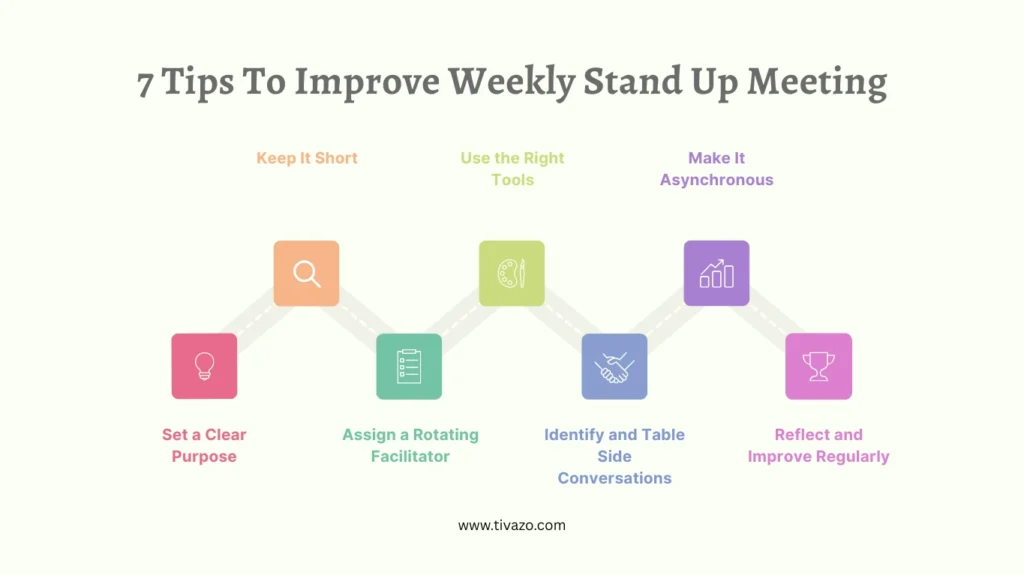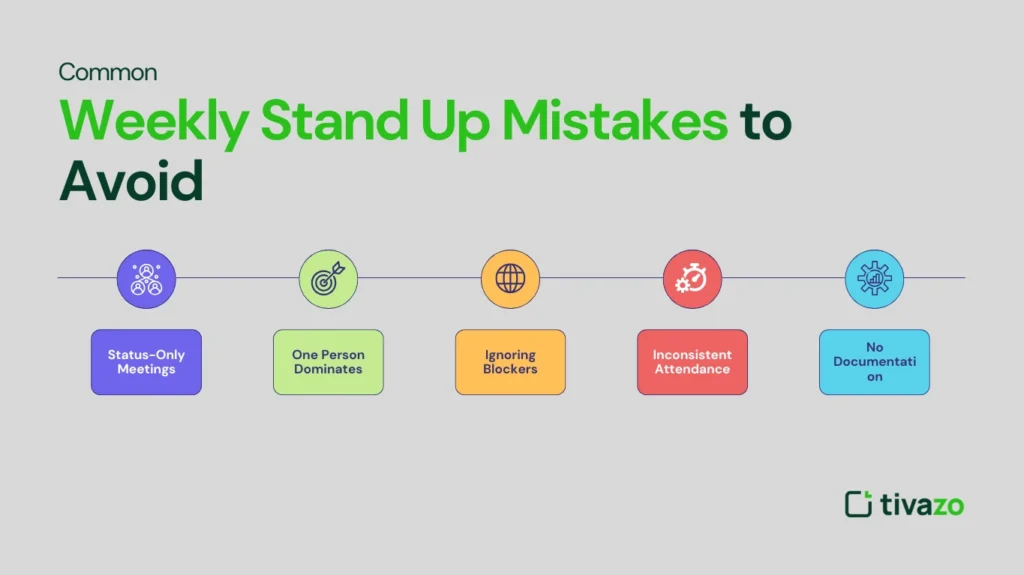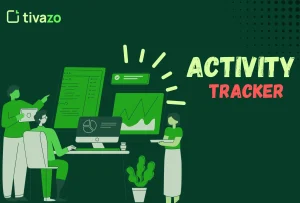A weekly stand up meeting may pull your team forward or sap the energy of all the team members. The difference? The effectiveness of how you run them.
An organized weekly stand up will keep the team in line, block flags early, and increase productivity during team meetings. However, these meetings too frequently amount to extended status updates or non-relevant chats that kill momentum.
What should you do to make the weekly stan -up meeting more efficient? It is a secret that in the updates, they should be equal, to the point, and concerned with the progress of the sprint examination and a stand-up meeting agenda. Regardless of whether you are conducting remote stand-up meetings or agile team check-ins, here are the tips on how to perfect the use of time and communication within the context of agile teams so that you make the best out of every minute.
In this post, we look at what a weekly stand up meeting involves and the tested and experimented tips you can utilize to turn over your weekly team syncs into effective collaboration sessions to drive your projects along.
Key Highlights:
- 7 Tips to Improve Your Weekly Stand Up Meeting In the Workplace
- Common Weekly Stand Up Mistakes to Avoid
- How Can Tivazo Help With Your Weekly Stand Up Meeting?
What is a weekly stand-up meeting?
A weekly stand up meeting is a short and targeted check-in of the team, which typically takes 10-15 minutes. It is intended to exchange information on what has been achieved during the week previous to the one coming, what will be done during the next week, and what the blockers are. It is typical of agile working culture and teleproject stand-up meetings, and it increases transparency, accountability, and team coordination.
In contrast to the daily stand-ups, meetings that happen once a week offer a high-level understanding of the progress, which could be discussed by the team that works on various projects or distributed between the time zones. Tools such as Slack or Loom and a clear list of stand-up meeting agenda items also help to make those meetings productive and efficient.
7 Tips to Improve Your Weekly Stand Up Meeting In Workplace
A well-run weekly stand up meeting is a very effective thing with well-managed teamwork and communication. With just some tricks of the trade, you can make your team focused, aligned, and motivated week in and week out.

1. Set a Clear Purpose
A successful weekly stand up meeting always has a purpose. When there is no clear purpose of the meeting, it can easily get out of control, and the members of the team will be at a loss for how to proceed. The essential goal should be to give a brief report on what everyone achieved the previous week, what they will do the following week, and whether they are going against any blockers that delay the work. This easy form makes the discussion relevant and fruitful.
By adhering to this three-question format, the team would also be held accountable and transparent in the meeting. Asana suggests that the same practice promotes improved dialogue and guarantees that all parties are aware of what needs to be prepared prior to the meeting. This minimizes the risk of losing the path and making the session look more like a status report.
To further spur such clarity, it can be a good idea to present the three fundamental questions boldly, be it your calendar invite, team management project tools such as Trello or Asana, or even during that very meeting. This maintains the sharpness of the focus and keeps the participants in mind what the stand up is all about. Once everybody knows what the purpose is, the weekly stand up meeting will be a useful touchpoint, rather than an add-on on the agenda.
2. Keep It Short
Respecting the time of everyone is one of the greatest problems of organizing a weekly stand up meeting. The meetings are preferably not taken above 15 minutes. More than that, you will lose focus and engagement, and instead of having a sync that is easier than a brisk walk, turn a quick sync into an exhausting session. Short and jerky messages serve to keep everyone pumped up, yet urge everyone to be concise.
Atlassian indicates that shorter meetings also reduce context switching, a cognitive cost incurred during individuals’ transitions between working on tasks and interruptions. In such a case, when your stand-up is brief and organized, team members can regain their momentum more easily to resume deep work. This minuscule efficiency increase can be translated to massive returns in the long run, particularly those that are quick-turn or stressful.
In order to sustain this shortness, it is necessary not to transform the stand up into a problem-solving arena. Concerns that were brought up ought to be given a tick and touched on later in a different discussion. To make sure your team does not waste time in stand up meetings, it is advised that the meeting be short and straight to the point in order to compensate team members with their own time and keep them charged towards upcoming activities.
3. Assign a Rotating Facilitator
Role rotation of the facilitator of your weekly stand up meeting can mean a large difference when it comes to engagement and ownership. The meeting will be boring if the same individual facilitates all the sessions. Shifting of facilitating allows other team members to take their place, learn to be leaders, and also provide some energy and insight to the process.
The presence of a facilitator also guarantees a smooth interaction within the meeting. The guide also stated that one of the functions of a facilitator is to handle time, hold up a schedule, and occasionally redirect discussions back to the priority updates when they drift out from it. This is to prevent distractions and also ensure that the meeting will be efficient and not wasteful of the time of everyone.
In addition, the shifting of the facilitators encourages mutual accountability. It is an indication that the voice of each individual counts, not only when it comes to providing updates, but also when taking charge of the communication pace within the team. Working together leads to more accountability and contribution to the weekly stand up meeting, hence making the experience more active and interactive.
4. Use the Right Tools
The proper tools are essential in a modern hybrid and remote working world to conduct successful weekly stand up meetings. The use of memory or oral updates is a sloppy system that might cause miscommunication and forgotten work. Software such as Asana or ClickUp enables teams to follow the progress in a transparent way and pay attention to all members of the team staying on track between meetings.
When the team is remote, it makes communication tools such as Slack, Zoom, and Loom useful. The examples include asynchronous updates through video messages that allow team members to provide brief overviews without derailing deep work on a timely basis. GitLab Remote Work Guide supports the idea because written communication combined with asynchronous communication is inclusive and can be efficient due to the time zone difference.
Storing all the meeting notes and action items in centralized tools, such as Notion or Confluence, will provide trustworthy documentation on which teams can rely at any given time. This transparency limits duplicated queries and puts blockers in plain view. Once your weekly stand up meeting has the right tech stack behind it the collaboration is easy, even when your entire team is not in the same room.
5. Identify and Table Side Conversations
The most obvious trap of using weekly stand up meetings is wasting time with chit-chats or solving complex problems. As much as it is important to deal with blockers, such discussions ought not to be part of the stand up, as it makes the venue time-consuming. Respecting everyone and especially their time is very easy to accomplish by setting aside a discussion area, commonly referred to as a parking lot.
A parking lot is fundamentally a spot-like area included in the meeting notes or a whole document in which the sides that are off-topic are noted in order to be discussed later. This ensures that the stand up meeting sticks to its agenda, which is fast updates and blocker identification, rather than problem resolution. It is also a sign of respect for the time of the attendees since it does not take too many detours during the meeting.
Scheduling follow-ups for items in the parking lot ensures that important issues get the attention they deserve without derailing the stand up. This balance between focus and flexibility helps your team stay productive and maintains the value of your weekly stand up meeting as a quick, energizing checkpoint.
6. Make It Asynchronous
Asynchronous weekly stand up meetings are a life force when teams are in different time zones or calendars are pushed to the limit. Rather than meeting everyone live, members of the team make short notes of updates they see, typically with the video tool Loom, which members view at their leisure. This gives flexibility minimizes scheduling headaches, and ensures workflow.
The design department of Atlassian introduced asynchronous stand ups and experienced greater participation and reduced context switching. The use of asynchronous updates enables member of teams to provide their reports with some elements of personality and creativity, which increases the level of team interconnectedness even when they are not together. This is a system that remote or hybrid teams miss as they long to have a flexible workplace.
Naturally, asynchronous stand ups have to be properly outlined to be prompt and informative. This format has the potential to uphold transparency and accountability and avoid meeting fatigue experienced in synchronous sessions when accompanied by blockers, follow-up meetings, or chat discussions.
7. Reflect and Improve Regularly
The ideal weekly stand up meetings develop with time. What the first team does may not be the same as what the second team should be doing, and as projects evolve, so should your stand up format. A brief retrospective after 4-6 weeks will foster constant development and is really worth taking the time.
Informal retrospectives may include: Polls, a quick survey to everyone on Slack, an anonymous survey, or a simple team talk. The reflection, according to Guidde, allows teams to notice points of pain, such as timing, engagement declines, or when an agenda is not clear. Discussing these firsts makes the meeting fresh and useful.
Through this attitude of iteration and feedback, it is through this attitude that you make your weekly stand up meeting a breathing thing and not a lifeless routine. This flexibility will enhance participation, and morale, and ensure that the communication between your team remains effective and in line with the current requirements.
Applying these seven tips will transform your weekly stand up meeting into a powerful tool for team alignment and productivity. When done right, this simple ritual can keep your workplace energized, accountable, and ready to tackle the week ahead.
Common Weekly Stand Up Mistakes to Avoid
The worst enemies exist even in the best teams to create traps that may decrease the effectiveness of their weekly stand up meeting. Learning about such pitfalls may assist you in making your work meetings productive and invigorating.

1. Status-Only Meetings
Converting the weekly stand up meeting into a one-way status report kills the engagement. Rather, emphasize valuable updates, blockers, and super-fast team check-ins that promote collaboration and problem-solving out of the meeting.
2. One Person Dominates
Once a single team member monopolizes the discussion, everybody goes off-tune, and key developments are not picked up. To ensure equal participation it is advised to have a time limit and the facilitator to be random so as to involve everyone.
3. Ignoring Blockers
When blockers are not brought to the surface or an effort takes place to follow up on them, progress on projects is slowed down and the staff is frustrated. Find time to list the obstacles that are encountered in your weekly stand up meeting and you should make sure that they are resolved as soon as your meeting is over.
4. Inconsistent Attendance
The need to miss weekly stand ups disrupts team alignment and causes a communication breach. Make such meetings non-negotiable, which can be ensured by attending these meetings on time and regularly.
5. No Documentation
A failure to note down updates or action items causes one to forget about what should be done and ask the same question many times. With shared tools it is now easy to record notes of some important messages in your weekly stand up meeting so that the entire team can have easy access to them.
These pitfalls should be avoided to ensure that your weekly stand up meeting is sharp, focused, and actually of value to your team. By catching these errors early on and nipping them, these mistakes will ensure that your meetings will produce enhanced communication, responsibility, and momentum.
How Can Tivazo Help With Your Weekly Stand Up Meeting?

Tivazo makes it so that you can have highly effective weekly stand up meetings using teams that have visibility on what is happening in their specific area of work in real-time. Automated recording of time, visual dashboards, and charts of the activity carried out throughout the week would ensure that the team can easily look at what was done within the week.
This will make the team check-ins more efficient and result-oriented allowing you to see the blockers coming to destroy the progress. Rather than leaving status updates as something unclear, your stand-up meeting agenda is well-anchored in the facts. Tivazo also records live screen shots and metrics of key productivity so that the team members are on track and accountable which is particularly useful when it comes to remote teams or working partially in the office and at home.
Following every stand-up meeting in a week, Tivazo will produce reports which can be shared by the whole team and is presented in a clear manner and showing time used on various tasks, the sprint status, and the overall project state. The reports may be shared or sent to stakeholders to encourage transparency and follow-up. You will be able to build your own project tracking systems, set up your own automatic reminders, and watch trends on visual analytics.
Tivazo helps any team: remote or in-office, transform every weekly stand-up into a purposeful results-oriented meeting that increases communication, accountability, and team performance.
Final Thoughts
Your weekly stand up meeting isn’t just another calendar invite. When done right, it’s the glue that holds teams together, drives momentum, and fosters a culture of ownership.
Use these smart strategies, backed by tools and insights from leaders like Asana, Atlassian, and Guidde, to elevate your meetings from passive updates to powerful progress checkpoints.
Now, ask yourself: is your weekly stand up helping your team win, or just filling time?
FAQ’s
What is a weekly scrum meeting?
A weekly scrum meeting is a type of weekly stand-up where the team reviews sprint progress, discusses challenges, and plans next steps, following Agile Scrum principles.
What to discuss during a stand-up meeting?
Discuss what you accomplished since the last meeting, what you will work on next, and any blockers or issues needing attention.
How long should a stand-up meeting last?
Stand-up meetings should last 10–15 minutes to keep updates brief, focused, and efficient.




